What is finding your style?
Discovering patterns in what clothing you personally prefer or dislike.
What does finding your style do?
- Clothes
Helps express your identity
How do I find my style?
Finding your own personal fashion style can take time. The more you experiment, the more you will find things you feel comfortable and confident in. Expect your style to keep evolving over time as you learn more about what you like.
Once you’ve started to get a basic idea of what you like, you can start to consider how you might adapt it to different situations, like different types of weather, work and education, or formal occasions.
Finding style ideas
There are lots of places you could look for inspiration:
- movies, TV, books, and magazines
- people you watch on YouTube, TikTok, or Twitch
- other people’s outfits at activities you enjoy like gigs or events for your hobbies
- fashion accounts on Instagram, Pinterest, or Tumblr
- fashion apps like Combyne, Fashmates, or Chicisimo
- fashion magazines and blogs
You might also be able to narrow down what you do and don’t like from other things:
-
What do you like and dislike?
Are there things you hate wearing? What have you bought and never worn? What things do you find ugly?
-
What do you find comfortable or uncomfortable?
Is the fit of some clothes uncomfortable for you? Do you find tight clothing, or particular types of fabrics and materials, difficult to wear?
-
What do you want to show or reveal?
Are there parts of your body where hiding them would make you feel more comfortable? You can find ideas about how to do this in our article about using clothing to disguise your body shape.
Getting help from other people
While other people can’t tell you whether something is right for you or not, if you talk through your ideas with other people, they may be able to suggest things you haven’t thought of yourself. It can also be more fun experimenting with someone else: they could tell you about options you haven’t considered, things that have worked well for them in the past, or if an item of clothing is providing the effect you want. They can even take photos of you in different looks for you to look through and think about later on.
Other people can also be a good source of clothes to try on. Do you have friends or family who you could ask to let you experiment trying on their clothes? If you don’t, some communities have clothes collections run by LGBT and trans organisations where you can try different types of clothes on, or clothes swaps where you can drop off clothes you no longer need and pick up new ones.
You can also get advice from a professional stylist. This is someone who can suggest clothes and ideas based on what you say you like. You can access them through:
- high-street retailers like Debenhams, John Lewis, or Topshop
- online fashion services like StitchFix or Lookiero
- independent agencies, some of which specifically advertise services to trans clients, like Born, Rachel Watson, or TRANS.style
Trying things out
Sometime you will know straight away if something is right for you, but often you need to try something out to discover whether it is right for you.
It can be much easier to try out a new style in a place where you feel safe from judgement. This can help you feel much more confident if you wear things in public later. Some places you could try experimenting with looks are:
-
At home
If you have friends or family who are accepting and supportive, you could try wearing clothes around them in your home.
-
Websites and apps
You may be able to find supportive environments in social networking apps or websites, forums, or group chats. However, it is important to remember that it can be very difficult to keep things that you post totally private, and things may be seen by people you didn’t expect. If you are under 18, it’s especially important to think about your safety, and you can find advice about how to stay safe online on the Childline website.
-
In games
Many games allow you to create characters or customise outfits in different styles. Some allow you lots of choice and a realistic set of outfits, such as The Sims, Animal Crossing, Pokemon Sword and Shield, or Forza Horizon 4. You can also experiment with lots of options in the Xbox Avatar Editor or in Second Life.
-
In LGBT spaces
You may feel safer and more able to experiment around other people who dress unconventionally or follow gender norms less strictly. Good places for this can be a local LGBT group, a LGBT support centre or venue, or a Pride event.
-
At local trans groups
Local groups for trans people may have an accepting environment or even provide changing rooms for you to change into different clothing when you arrive. You can find trans groups near to you on our page of local organisations, TranzWiki, or TransUnite.
More ideas
If you’re looking for inspiration, here are some possibilities to consider for how colour can fit into your style.
-
Black and white

-
Black and an accent colour
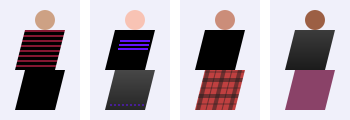
-
Neon colours
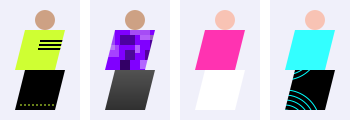
-
Natural shades
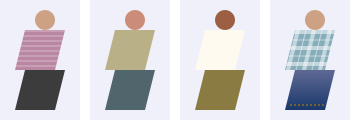
-
Contrasting colours

-
Vivid primary colours

-
Pale pastels
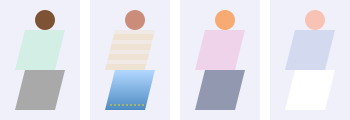
-
Bright light colours

-
Matching hues

-
Reds and oranges
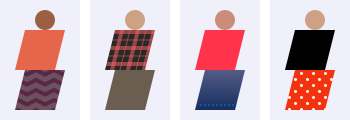
-
Greens and teals
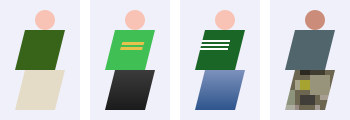
-
Blues
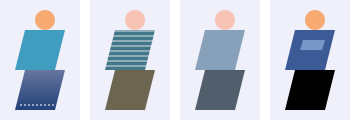
-
Purples and pinks
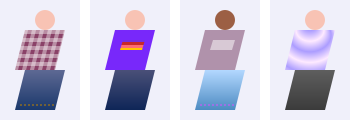
-
Clashing colours
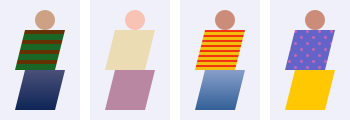
-
Multicoloured

Where can I learn more?
You can find more useful information in our article about buying clothes.
For more clothing support, resources, and advice for LGBTQ+ gender non-conforming and trans people based in the UK, check out the G(end)er Swap CIC website.
Acknowledgements
This page is illustrated using a photograph by Waldemar Brandt available at Unsplash.
Errors and omissions
Is there something missing from this page? Have you spotted something that isn't correct? Please tweet us or message us on Facebook to let us know, or file an issue on GitHub.
